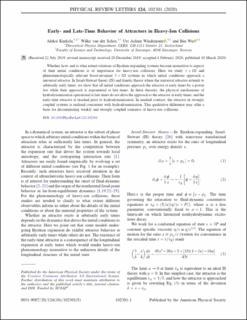| dc.contributor.author | Kurkela, Aleksi | |
| dc.contributor.author | van der Schee, Wilke | |
| dc.contributor.author | Wiedemann, Urs Achim | |
| dc.contributor.author | Wu, Bin | |
| dc.date.accessioned | 2023-01-06T12:14:16Z | |
| dc.date.available | 2023-01-06T12:14:16Z | |
| dc.date.created | 2020-11-12T10:40:45Z | |
| dc.date.issued | 2020 | |
| dc.identifier.citation | Kurkela, A., van der Schee, W., Wiedemann, U. A., & Wu, B. (2020). Early-and late-time behavior of attractors in heavy-ion collisions. Physical Review Letters, 124(10), 102301. | en_US |
| dc.identifier.issn | 0031-9007 | |
| dc.identifier.uri | https://hdl.handle.net/11250/3041573 | |
| dc.description.abstract | Whether, how, and to what extent solutions of Bjorken-expanding systems become insensitive to aspects of their initial conditions is of importance for heavy-ion collisions. Here we study 1+1D and phenomenologically relevant boost-invariant 3+1D systems in which initial conditions approach a universal attractor. In Israel-Stewart theory (IS) and kinetic theory where the universal attractor extends to arbitrarily early times, we show that all initial conditions approach the attractor at early times by a power law while their approach is exponential at late times. In these theories, the physical mechanisms of hydrodynamization operational at late times do not drive the approach to the attractor at early times, and the early-time attractor is reached prior to hydrodynamization. In marked contrast, the attractor in strongly coupled systems is realized concurrent with hydrodynamization. This qualitative difference may offer a basis for discriminating weakly and strongly coupled scenarios of heavy-ion collisions. | en_US |
| dc.language.iso | eng | en_US |
| dc.publisher | American Physical Society | en_US |
| dc.rights | Navngivelse 4.0 Internasjonal | * |
| dc.rights.uri | http://creativecommons.org/licenses/by/4.0/deed.no | * |
| dc.title | Early- and Late-Time Behavior of Attractors in Heavy-Ion Collisions | en_US |
| dc.type | Peer reviewed | en_US |
| dc.type | Journal article | en_US |
| dc.description.version | publishedVersion | en_US |
| dc.rights.holder | the authors | en_US |
| dc.subject.nsi | VDP::Matematikk og Naturvitenskap: 400::Fysikk: 430 | en_US |
| dc.source.volume | 124 | en_US |
| dc.source.journal | Physical Review Letters | en_US |
| dc.source.issue | 10 | en_US |
| dc.identifier.doi | 10.1103/PhysRevLett.124.102301 | |
| dc.identifier.cristin | 1847307 | |
| dc.source.articlenumber | 102301 | en_US |
| cristin.ispublished | true | |
| cristin.fulltext | original | |
| cristin.qualitycode | 2 | |

